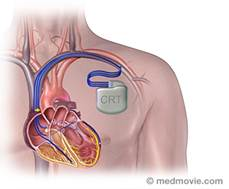 |
Cardiac Resynchronization Therapy- Pacemaker (CRT-P) Pre Procedure Instructions-TUKH
|
A Cardiac Resynchronization Therapy-Pacemaker (CRT-P) is a device that that monitors and may be able to treat some heart arrhythmias. The goal is also to help improve weak heart pumping function. Weak pumping function can have multiple causes and may also be referred to as heart failure.
Heart failure is a condition in which the heart muscle has become weak. It can be caused by an electrical problem, a blood flow problem or other chronic conditions. Your Doctor can discuss these with you. With heart failure the chambers of the heart may not be in sync so the bottom chambers of the heart (ventricles) lose some of their ability to pump effectively. This can make heart failure worse.
The CRT-P has two basic parts:
- Pulse generator (which houses the battery and circuitry)
- Leads, there are usually 2 or 3 wires that connect to different chambers of the heart.
The leads have 2 purposes:
- Allow the device to “see” heart beats
- Carry the electrical impulses (make the heart beat or “pace”).
This device is also called a biventricular pacemaker (pacemaker with leads in both ventricles) or resynchronization pacemaker (as it is intended to re-synchronize the heart chambers and improve pumping).
The “pacemaker” function in your CRT-P is used make your heart chambers beat in sync. The leads allow the device to “see” heart beats and can send electrical signals(pacing) to the different chambers in the heart (atria and ventricles).
- When all of the chambers are in sync the heart pumps better.
- The goal is to pace the ventricles as close to 100% of the time as possible or synchronize the ventricles (pumping chambers) of the heart with every beat.
- This can improve some symptoms of heart failure.
CRT-P won’t replace other heart failure treatments. It is part of a complete heart failure treatment plan. CRT-P helps a weakened heart do a better job of pumping blood out of the heart with each beat so more blood and oxygen goes to the rest of your body. This can decrease heart failure symptoms and improve survival. Not everyone with heart failure will benefit from a CRT-P. The CRT-P will improve symptoms in about 2 out of 3 people who get it and may require several adjustments to make the settings optimal for you and your body.
Your CRT-D is implanted by an electrophysiologist; a cardiologist specializing in the electrical system of the heart. Your CRT-D will be implanted in a room in the electrophysiology laboratory.